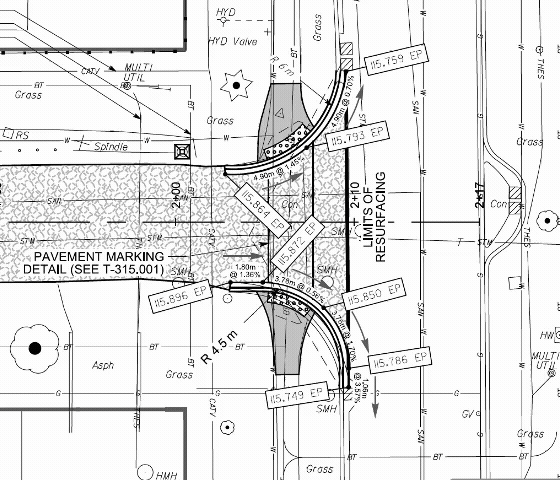Contract Etobicoke B (6 Projects)
Design -> Tender : May 2024 -> January 2025
Design -> Tender :
May 2024 -> January 2025
The 2.5 km contract encompasses six resurfacing sections, two of which were initially planned for reconstruction. However, scope adjustments enabled a practical reduction in both scope and budget. A critical aspect of this project is the urgent regrading of ditches, which have become buried over time, leading to road ponding and numerous resident complaints. Furthermore, all ditch catch basins will be replaced with birdcage grate catch basins to enhance water flow, minimize debris blockages, and improve safety for both pedestrians and cyclists. Although a consultant was initially appointed to oversee the project, they withdrew due to the contract’s complexity, particularly regarding the construction process. As a result, we decided to manage the project in-house to ensure timely and efficient delivery.
Before
Transportation Services has requested this project in response to multiple 311 service requests from residents concerning poor drainage performance in the area. During storm events, existing roadside ditches fail to properly convey runoff, resulting in localized flooding and water encroaching onto private properties. In addition, the roadways within this contract have reached the end of their service life. The pavement surfaces exhibit widespread cracking and structural deterioration, warranting full reconstruction.

Designed corner reconstruction improvements to enhance pedestrian safety and accessibility at a local intersection in Etobicoke. The curb radii were reduced to calm vehicle turns and shorten crossing distances. Landing pads were widened and fitted with tactile walking surface indicators (TWSIs) to meet AODA standards and improve accessibility for all users. The design also optimized grades and resurfacing limits to ensure smooth transitions and proper drainage.
Designed corner reconstruction improvements to enhance pedestrian safety and accessibility at a local intersection in Etobicoke. The curb radii were reduced to calm vehicle turns and shorten crossing distances. Landing pads were widened and fitted with tactile walking surface indicators (TWSIs) to meet AODA standards and improve accessibility for all users. The design also optimized grades and resurfacing limits to ensure smooth transitions and proper drainage.


The project presented challenges due to its flat longitudinal slopes and cross falls, which increased the risk of pooling and sediment buildup around traditional ditch catch basins.
The project presented challenges due to its flat longitudinal slopes and cross falls, which increased the risk of pooling and sediment buildup around traditional ditch catch basins.

To address this, we implemented birdcage catch basins, which offer improved inlet capacity and reduced clogging, while also weighing the trade-offs related to debris loads and maintenance needs.
To address this, we implemented birdcage catch basins, which offer improved inlet capacity and reduced clogging, while also weighing the trade-offs related to debris loads and maintenance needs.

Designed traffic-calming measures for several residential and collector roads in the Etobicoke area to make streets safer and calmer. The design was based on detailed traffic analysis — including speed and volume studies showing drivers averaging up to 15 km/h over the limit — and community surveys where most residents supported adding speed humps. The project introduced speed humps, all-way stops, and lower speed limits on key streets to improve pedestrian comfort and neighbourhood livability.
Designed traffic-calming measures for several residential and collector roads in the Etobicoke area to make streets safer and calmer. The design was based on detailed traffic analysis — including speed and volume studies showing drivers averaging up to 15 km/h over the limit — and community surveys where most residents supported adding speed humps. The project introduced speed humps, all-way stops, and lower speed limits on key streets to improve pedestrian comfort and neighbourhood livability.







